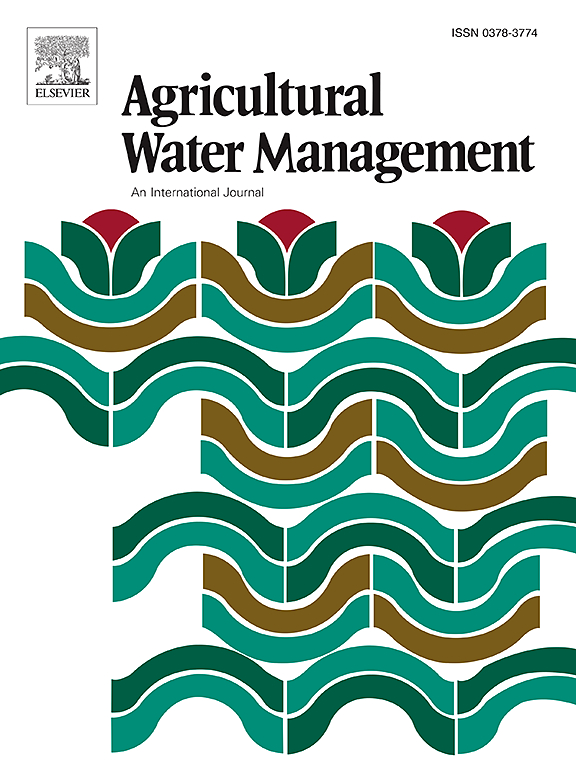在湿润地区通过水氮管理提高水稻-油菜轮作的可持续性
IF 5.9
1区 农林科学
Q1 AGRONOMY
引用次数: 0
摘要
由于目前的水分和养分管理方法,密集型种植系统面临着巨大的环境和经济挑战。本研究针对水稻-油菜轮作中优化这些措施的有限研究进行了探讨,重点是通过改进水和氮管理来提高可持续性。利用 DSSAT 作物生长模型,我们评估了水稻的三种灌溉方案--I1(100% 灌溉要求:IR)、I2(80% IR)和 I3(60% IR)--以及三种氮肥施用水平:N1(低于 RAN:地区平均氮含量的 30%)、N2(RAN)和 N3(高于 RAN 的 30%)。分析了关键的可持续性指标,包括水分生产率(WP)、氮利用效率(NUE)和经济生产率。DSSAT 模型显示出很高的预测准确性,观测值与模拟值之间的产量差异仅为:水稻 236 千克/公顷-¹,油菜籽 121 千克/公顷-¹。在 I3N2 条件下,如果用水量减少 40%,水稻产量最高可达 5654 千克/公顷。此外,用水量的减少导致生产成本下降 27%,水稻的可湿性粉剂、净效益和总效益分别显著提高 46.7%、43.1% 和 47.9%。相反,油菜籽氮肥施用量增加 30%,产量增加 9%,这突出表明了因地制宜的氮肥策略的重要性。此外,与目前的氮施用水平相比,氮3可使油菜籽的WP、NUE、净效益和总效益分别提高6.7%、1.4%、9.1%和9.2%。总之,本研究说明了在水稻种植中大量节水的潜力,同时建议稳定或减少氮的施用量。这些管理策略提高了农场绩效,降低了生产成本,有助于水稻-油菜种植系统的可持续发展,同时提高了农业生产率和环境管理水平。本文章由计算机程序翻译,如有差异,请以英文原文为准。
Improving sustainability of rice-canola rotation through water and nitrogen management in a humid region
Intensive cropping systems face significant environmental and economic challenges due to current water and nutrient management practices. This study addresses the limited research on optimizing these practices in rice-canola rotations, focusing on enhancing sustainability through improved water and nitrogen (N) management. Utilizing the DSSAT crop growth model, we evaluated three irrigation scenarios for rice- I1 (100 % irrigation requirement: IR), I2 (80 % IR), and I3 (60 % IR)-alongside three N application levels: N1 (30 % below RAN: regional average N), N2 (RAN), and N3 (30 % above RAN). Key sustainability indicators, including water productivity (WP), nitrogen use efficiency (NUE), and economic productivity, were analyzed. The DSSAT model demonstrated strong predictive accuracy, with yield differences of only 236 kg ha⁻¹ for rice and 121 kg ha⁻¹ for canola between observed and simulated values. A 40 % reduction in water use increased rice yield to a maximum of 5654 kg ha⁻¹ under I3N2 conditions. Additionally, this reduction in water consumption resulted in a 27 % decrease in production costs, significantly enhancing WP, net benefits, and gross benefits of rice by 46.7 %, 43.1 %, and 47.9 %, respectively. Conversely, a 30 % increase in N application for canola correlated with a 9 % yield increase, underscoring the importance of tailored N strategies. Furthermore, N3 raised WP, NUE, net benefits, and gross benefits of canola by 6.7 %, 1.4 %, 9.1 %, and 9.2 %, respectively, compared with current N application level. Overall, this study illustrates the potential for substantial water savings in rice cultivation while recommending stable or reduced N application levels. These management strategies enhance farm performance, lower production costs, and contribute to the sustainability of rice-canola cropping systems, promoting both agricultural productivity and environmental stewardship.
求助全文
通过发布文献求助,成功后即可免费获取论文全文。
去求助
来源期刊

Agricultural Water Management
农林科学-农艺学
CiteScore
12.10
自引率
14.90%
发文量
648
审稿时长
4.9 months
期刊介绍:
Agricultural Water Management publishes papers of international significance relating to the science, economics, and policy of agricultural water management. In all cases, manuscripts must address implications and provide insight regarding agricultural water management.
 求助内容:
求助内容: 应助结果提醒方式:
应助结果提醒方式:


